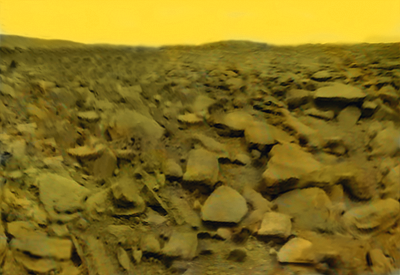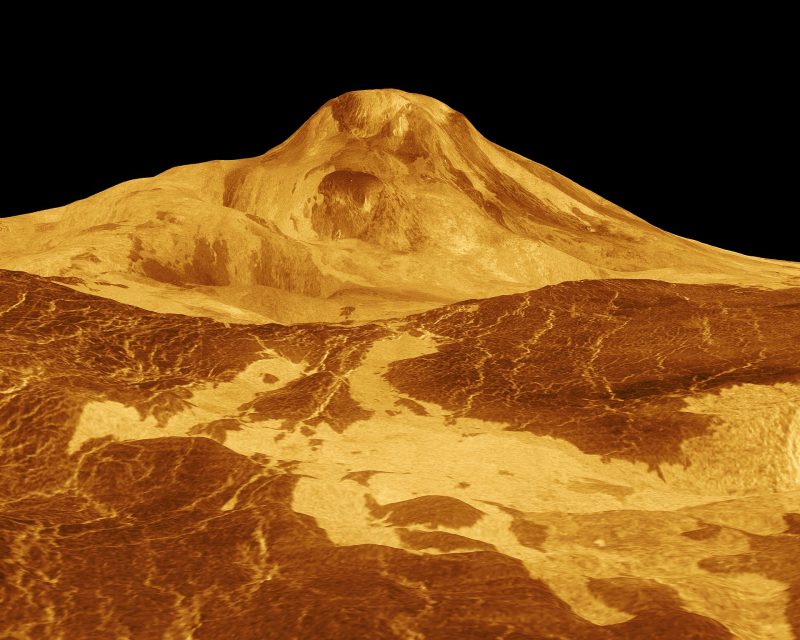

Artist’s concept of an ancient planet Venus, with a shallow ocean. Image via NASA.
The second planet outward from our sun – Venus, named for the Roman goddess of love – is Earth’s near-twin in size and density. But it’s a hellish place, with dense clouds of carbon dioxide laced with sulfuric acid. Its surface pressure is 90 times that of Earth, and its surface temperatures are hot enough to melt lead. Yet – at last week’s international meeting of astronomers in Geneva, Switzerland, Michael Way of NASA presented a very different view of Venus. He said on September 20, 2019 that new research reveals Venus may once have been a temperate world, more like Earth, with a shallow ocean of liquid water on its surface for some 2 to 3 billion years. The new research suggests that, only around 700 million years ago, a dramatic transformation began for Venus, ultimately resurfacing some 80% of our sister world. These scientists said in a statement that their study:
… gives a new view of Venus’s climatic history and may have implications for the habitability of exoplanets in similar orbits.
This isn’t the first time scientists have contemplated liquid water on Venus. NASA’s Pioneer-Venus mission – which visited the planet 40 years ago – found tantalizing hints of long-gone shallow ocean. To see if Venus might ever have had a stable climate capable of supporting liquid water, Way and his colleague, Anthony Del Genio, created five different computer simulations of Venus in the past. Each assumed a different level of water coverage. In all five scenarios, these scientists found that Venus was able to maintain stable temperatures between a maximum of about 122 degrees Fahrenheit (50 degrees C) and a minimum of about 68 degrees F (20 degrees C) for around three billion years.
Hotter than Earth, yes, but a far cry from the average temperature of 865°F (462 degrees C) on Venus today. If one of these scenarios describes something akin to Venus in the past, what happened to change things?

This modified image is based on the 1st-ever image from the surface of Venus, returned by the Soviet Venera 9 spacecraft in 1975. Looks harsh, doesn’t it? Image via Venera 9 and Ted Styrk’s blog. Read more about this image from the Planetary Society.
According to these scientists, Venus might have maintained its temperate climate until today, if not for a series of events that caused a release, or ‘outgassing’, of carbon dioxide stored in the rocks of the planet approximately 700 to 750 million years ago.
As we all should know by now, carbon dioxide is a greenhouse gas: it traps heat.
The cause of this outgassing is a mystery, these scientists said, but it might be linked to volcanic activity on Venus:
One possibility is that large amounts of magma bubbled up, releasing carbon dioxide from molten rocks into the atmosphere. The magma solidified before reaching the surface and this created a barrier that meant that the gas could not be reabsorbed. The presence of large amounts of carbon dioxide triggered a runaway greenhouse effect, which has resulted in the scorching 462-degree average temperatures found on Venus today.
Did it happen? Was Venus more temperate in the past? We don’t know. Computer simulations such as these serve to show not what did happen, but what could happen. The scientists acknowledged “two major unknowns:”
The first relates to how quickly Venus cooled initially and whether it was able to condense liquid water on its surface in the first place. The second unknown is whether the global resurfacing event was a single event or simply the latest in a series of events going back billions of years in Venus’s history.

Although we haven’t found an active volcano on Venus yet, we know Venus has volcanic features and that volcanos have been active there recently, in geologic terms, within the last several million years. In fact, as of now, Venus is known to have more volcanoes than any other planet in our solar system: over 1,600 major volcanoes. Here is Maat Mons on Venus, the highest volcano on Venus, 5-miles (8-km-) high. This perspective view is based on Magellan radar images. Read more via NASA PhotoJournal.
Way and his team also acknowledged in their statement that many researchers believe that Venus is beyond the inner boundary of our solar system’s habitable zone; it’s been suggested, in other words, that Venus is too close to the sun to support liquid water. But the new study suggests otherwise. Way said:
Venus currently has almost twice the solar radiation that we have at Earth. However, in all the scenarios we have modelled, we have found that Venus could still support surface temperatures amenable for liquid water.
This finding, if supported by other scientific work, may have implications for our understanding of exoplanets orbiting in distant solar systems. You’ve heard of the Goldilocks zone, or habitable zone? It’s the zone around a star in which orbiting planets are capable of supporting liquid water on their surfaces. Not too hot, not too cold, in other words. Maybe we don’t understand the true boundary of the habitable zone, either in the direction toward a solar system’s central star, or in the other direction, or in both directions. Maybe our understanding of habitables zones needs a tweak.
Of course, these scientists said, as scientists nearly always say upon the completion of any study, that more studies are needed. Way said:
We need more missions to study Venus and get a more detailed understanding of its history and evolution.
However, our models show that there is a real possibility that Venus could have been habitable and radically different from the Venus we see today. This opens up all kinds of implications for exoplanets found in what is called the ‘Venus Zone’, which may in fact host liquid water and temperate climates.

Venus is the brightest planet visible in Earth’s sky. Only the moon outshines it at night. Our friend Jenney Disimon caught the moon and Venus on June 2, 2019, from Kota Kinabalu, Sabah, N. Borneo. The extreme brightness for Venus stems in part from its highly reflective clouds, which trap heat near the planet, elevating temperatures. Read more about when we might see Venus in our sky again in EarthSky’s monthly planet guide.
Bottom line: Venus is a hellish world today. Did it ever have a stable climate or liquid water? To learn more, scientists created a series of 5 simulations assuming different levels of water coverage. In all 5 models, Venus maintained relativity moderate temperatures for around 3 billion years.
from EarthSky https://ift.tt/2mBADcO


Artist’s concept of an ancient planet Venus, with a shallow ocean. Image via NASA.
The second planet outward from our sun – Venus, named for the Roman goddess of love – is Earth’s near-twin in size and density. But it’s a hellish place, with dense clouds of carbon dioxide laced with sulfuric acid. Its surface pressure is 90 times that of Earth, and its surface temperatures are hot enough to melt lead. Yet – at last week’s international meeting of astronomers in Geneva, Switzerland, Michael Way of NASA presented a very different view of Venus. He said on September 20, 2019 that new research reveals Venus may once have been a temperate world, more like Earth, with a shallow ocean of liquid water on its surface for some 2 to 3 billion years. The new research suggests that, only around 700 million years ago, a dramatic transformation began for Venus, ultimately resurfacing some 80% of our sister world. These scientists said in a statement that their study:
… gives a new view of Venus’s climatic history and may have implications for the habitability of exoplanets in similar orbits.
This isn’t the first time scientists have contemplated liquid water on Venus. NASA’s Pioneer-Venus mission – which visited the planet 40 years ago – found tantalizing hints of long-gone shallow ocean. To see if Venus might ever have had a stable climate capable of supporting liquid water, Way and his colleague, Anthony Del Genio, created five different computer simulations of Venus in the past. Each assumed a different level of water coverage. In all five scenarios, these scientists found that Venus was able to maintain stable temperatures between a maximum of about 122 degrees Fahrenheit (50 degrees C) and a minimum of about 68 degrees F (20 degrees C) for around three billion years.
Hotter than Earth, yes, but a far cry from the average temperature of 865°F (462 degrees C) on Venus today. If one of these scenarios describes something akin to Venus in the past, what happened to change things?

This modified image is based on the 1st-ever image from the surface of Venus, returned by the Soviet Venera 9 spacecraft in 1975. Looks harsh, doesn’t it? Image via Venera 9 and Ted Styrk’s blog. Read more about this image from the Planetary Society.
According to these scientists, Venus might have maintained its temperate climate until today, if not for a series of events that caused a release, or ‘outgassing’, of carbon dioxide stored in the rocks of the planet approximately 700 to 750 million years ago.
As we all should know by now, carbon dioxide is a greenhouse gas: it traps heat.
The cause of this outgassing is a mystery, these scientists said, but it might be linked to volcanic activity on Venus:
One possibility is that large amounts of magma bubbled up, releasing carbon dioxide from molten rocks into the atmosphere. The magma solidified before reaching the surface and this created a barrier that meant that the gas could not be reabsorbed. The presence of large amounts of carbon dioxide triggered a runaway greenhouse effect, which has resulted in the scorching 462-degree average temperatures found on Venus today.
Did it happen? Was Venus more temperate in the past? We don’t know. Computer simulations such as these serve to show not what did happen, but what could happen. The scientists acknowledged “two major unknowns:”
The first relates to how quickly Venus cooled initially and whether it was able to condense liquid water on its surface in the first place. The second unknown is whether the global resurfacing event was a single event or simply the latest in a series of events going back billions of years in Venus’s history.

Although we haven’t found an active volcano on Venus yet, we know Venus has volcanic features and that volcanos have been active there recently, in geologic terms, within the last several million years. In fact, as of now, Venus is known to have more volcanoes than any other planet in our solar system: over 1,600 major volcanoes. Here is Maat Mons on Venus, the highest volcano on Venus, 5-miles (8-km-) high. This perspective view is based on Magellan radar images. Read more via NASA PhotoJournal.
Way and his team also acknowledged in their statement that many researchers believe that Venus is beyond the inner boundary of our solar system’s habitable zone; it’s been suggested, in other words, that Venus is too close to the sun to support liquid water. But the new study suggests otherwise. Way said:
Venus currently has almost twice the solar radiation that we have at Earth. However, in all the scenarios we have modelled, we have found that Venus could still support surface temperatures amenable for liquid water.
This finding, if supported by other scientific work, may have implications for our understanding of exoplanets orbiting in distant solar systems. You’ve heard of the Goldilocks zone, or habitable zone? It’s the zone around a star in which orbiting planets are capable of supporting liquid water on their surfaces. Not too hot, not too cold, in other words. Maybe we don’t understand the true boundary of the habitable zone, either in the direction toward a solar system’s central star, or in the other direction, or in both directions. Maybe our understanding of habitables zones needs a tweak.
Of course, these scientists said, as scientists nearly always say upon the completion of any study, that more studies are needed. Way said:
We need more missions to study Venus and get a more detailed understanding of its history and evolution.
However, our models show that there is a real possibility that Venus could have been habitable and radically different from the Venus we see today. This opens up all kinds of implications for exoplanets found in what is called the ‘Venus Zone’, which may in fact host liquid water and temperate climates.

Venus is the brightest planet visible in Earth’s sky. Only the moon outshines it at night. Our friend Jenney Disimon caught the moon and Venus on June 2, 2019, from Kota Kinabalu, Sabah, N. Borneo. The extreme brightness for Venus stems in part from its highly reflective clouds, which trap heat near the planet, elevating temperatures. Read more about when we might see Venus in our sky again in EarthSky’s monthly planet guide.
Bottom line: Venus is a hellish world today. Did it ever have a stable climate or liquid water? To learn more, scientists created a series of 5 simulations assuming different levels of water coverage. In all 5 models, Venus maintained relativity moderate temperatures for around 3 billion years.
from EarthSky https://ift.tt/2mBADcO

Aucun commentaire:
Enregistrer un commentaire